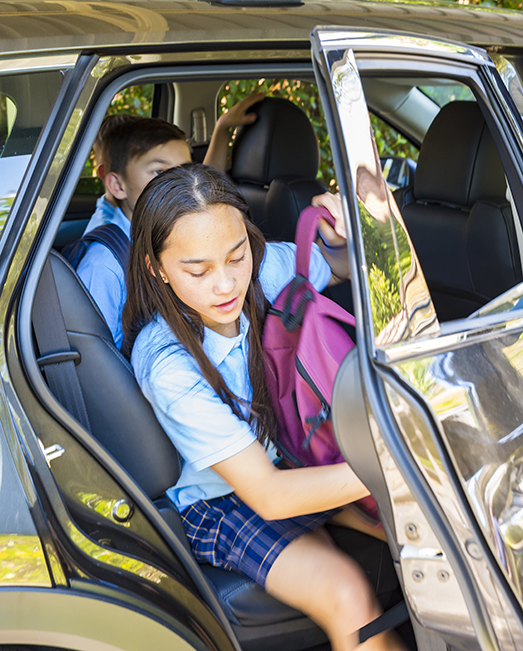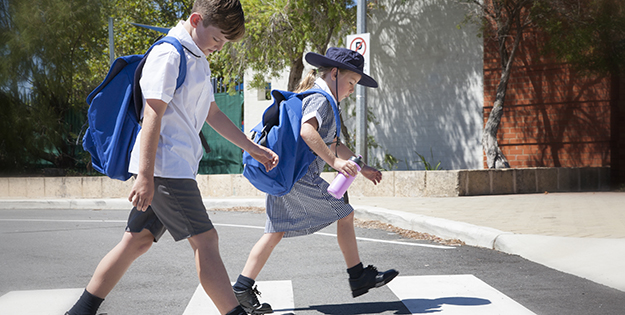Lifestyle
Copyright@ Australian Catholic University 1998-2025 | ABN 15 050 192 660 CRICOS registered provider: 00004G | PRV12008
Copyright@ Australian Catholic University 1998-2025 | ABN 15 050 192 660 CRICOS registered provider: 00004G | PRV12008

Busy lifestyles, poorly planned neighbourhoods and parental anxieties are creating a ‘backseat generation’ of kids who don’t walk, ride or skate to school.
It’s seen as every parent’s worst nightmare — a young child snatched by an unscrupulous kidnapper on the journey to or from school.
While such abductions are uncommon, they do happen, and the resulting parental fear has been identified as a key reason for the decline in ‘active transport’ in children.
The debate over whether kids should or shouldn’t walk to school on their own has become emblematic of the struggle parents face in balancing independence in children with the instinct to keep them safe.
In January 2019, ACU-led research was published in the Journal of Transport & Health, showing that three in five primary schoolchildren don’t walk or ride to school, and most parents — even those who live within a short stroll of the school gates — drop their kids off in a car.
When the study hit the headlines along with a warning that the rise in physical inactivity could lead to long-term health risks, defensive parents took to their keyboards.
“You seriously can’t win as a parent,” was one mother’s response. “Lazy for driving your kids to school but irresponsible for letting them walk. Parenting is hard enough without judgments like this being thrown around everywhere.”
Others identified child safety as a major issue.
“Too many kid snatchings these days,” one mother wrote. “We used to play all day around the neighbourhood and come home when the streetlights came on. Not safe these days!”
The study’s lead author, Dr Alison Carver, acknowledged that fear of abduction was one of several factors behind the decline in active transport.
“Kidnapping and abduction is a real concern,” said Dr Carver, a research fellow at ACU’s Mary MacKillop Institute.
“Statistics show that child abductions by strangers are extremely rare, but when such an incident does happen, it’s very sad and there’s a lot of media exposure, so I think these sorts of stories stay uppermost in parents’ minds.”
Some have attributed the widespread parental anxiety to high-profile cases like the kidnapping of nine-year-old Sydney schoolgirl Samantha Knight, who was snatched from near her mother’s Bondi home after school in August 1986.
Other more recent cases, like the abduction and alleged rape of an 11-year-old girl on her way to school in Newcastle in June 2018, have perpetuated that fear.
Dr Carver said parental concern about ‘stranger danger’ had been prominent in scientific literature for at least two decades. She said the decline of people circulating and socialising on suburban streets “feeds into the social fear”.
“I've talked previously about it being a vicious cycle, in that fewer people are walking and cycling on local streets, so people aren't aware of who's living in their neighbourhood and there's a real air of suspicion,” she said.
But while the fear of strangers is clearly a barrier to children travelling to school by themselves, there are other causes for the decline.
Concerns about traffic have also made parents hesitant to let their children travel to school independently.
Moreover, time-pressed parents commonly engage in ‘trip-chaining’, a scenario where mothers and fathers drop the kids off at school on the way to work or other errands.
“We have created a backseat generation,” Dr Carver said.
“It is quite shocking how many children who live within 750 metres of their school gates are still being driven … nowadays there are more households where both parents are working, so they're time poor and it's just easier to get in the car.”
Research over recent decades has consistently shown that the simple act of walking or riding a bike to school is increasingly uncommon.
In 1985, 37 per cent of children engaged in active transport to and from school; by 2001, only 26 per cent still did, according to a study of 8,484 Australian children aged between seven and 15. The rate of overweight and obese children went from 11.7 per cent to 28.7 per cent in that same period, representing a major public health concern.
Dr Carver’s study, which included a team of researchers from RMIT and the University of Melbourne, found that many children aren’t getting the recommended levels of physical activity.
This is a major worry, because physical inactivity has been linked to an increased risk of lower bone density and chronic diseases like cancer, mental health and cardiovascular disease.
“Active transport to school is a key opportunity for generating activity that's not based around sport, so they're not even thinking about being physically active – they just do it from habit,” Dr Carver said.
Furthermore, the study found kids who were chauffeured to and from school were more likely to be driven elsewhere.

“We looked at all trips they made throughout the day, and what we found was that if children weren't walking or cycling to school, they weren't walking or cycling to many other destinations,” she said, adding that active travel could help children form positive habits.
“If we can encourage children to be physically active when they're younger, we can really instil some healthy habits that they carry into their teenage years and into adulthood.”
As well as the physical aspects, children can benefit from social interaction on the way to school. The increased independence can help them gain confidence, build resilience, and assist them in navigating not only their neighbourhoods, but also the wider world.
However, those who criticised Dr Carver’s calls for parents to “stop and think” about the dangers of children living an inactive lifestyle pointed out that a lack of time, rather than fear or laziness, was the biggest factor.
“To be frank, it’s not an easy decision for me. My 11-year-old would love nothing more than to independently get himself to and from school, and it’s an issue between us,” wrote Mamamia’s Nama Winson.
“But for me, driving him on my way to work is the easiest, simplest, and safest option for us. So, sorry, but I ensure my son gets his fresh air and exercise at other times – just not on school mornings before 8.30am.”
“I did see that article,” Dr Carver said, “and I think the word ‘ouch’ was used when the writer introduced the research and said, ‘well, here we go, another person telling mothers what to do’.”
“That wasn't the intention of our research,” she said. “We simply want parents to be more mindful of the health benefits their children are missing out on by not walking or cycling to school.”
So how do we reverse the trend against active transport for schoolkids?
Dr Carver and her co-authors have called for improved infrastructure around schools, including reduced traffic risks and hazards, well-connected footpaths and bike trails, and ‘park and stride’ facilities, so parents can drop-off and pick-up their children 800 metres from the school gates.
She pointed to places with pedestrian and cycle-friendly neighbourhoods like Japan, where 93 per cent of children walk or ride to school.
“They also have school staff and volunteers scattered on typical routes that the children take to school, which acts as discrete surveillance and puts parents’ minds at ease,” she said.
The study also advocated educational campaigns, to help builds parents’ confidence in allowing their children to walk or cycle to school without adult accompaniment.
“Children under the age of 10 lack the skills to negotiate traffic safely, they're not good at perceiving the speed of cars, so this needs to be done gradually,” Dr Carver said.
“If parents walk or cycle with their children to school at the early stages, they can eventually transition and allow them to do it themselves or with their peers or siblings.”
The ultimate goal, says Dr Carver, is to make walking and cycling to school the norm for our children.
“Anything that encourages increased physical activity for children of school age is a step in the right direction.”
Dr Alison Carver’s research focuses on the impact of the built environment on health outcomes in children and older adults. She has published several research papers examining children's active transport and independent mobility.

Copyright@ Australian Catholic University 1998-2025 | ABN 15 050 192 660 CRICOS registered provider: 00004G | PRV12008